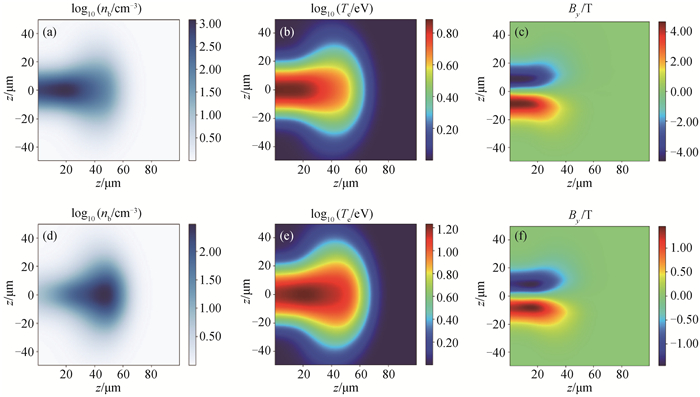Chinese Journal of Computational Physics ›› 2023, Vol. 40 ›› Issue (2): 222-231.DOI: 10.19596/j.cnki.1001-246x.8614
Special Issue: 贺贤土院士从事科学研究工作60周年暨激光聚变相关研究进展专刊
• The 60th Anniversary of Academician He Xiantu's Scientific Research Work: A Special Issue of Research Progress in Laser Fusion • Previous Articles Next Articles
Hua ZHANG1,2( ), Mingqiang LI2, Li PENG2, Minqing HE3, Sizhong WU1,2, Cangtao ZHOU1,2
), Mingqiang LI2, Li PENG2, Minqing HE3, Sizhong WU1,2, Cangtao ZHOU1,2
Received:2022-08-15
Online:2023-03-25
Published:2023-07-05
Hua ZHANG, Mingqiang LI, Li PENG, Minqing HE, Sizhong WU, Cangtao ZHOU. Fokker-Planck Equation for Superthermal Electron Energy Deposition[J]. Chinese Journal of Computational Physics, 2023, 40(2): 222-231.
Add to citation manager EndNote|Ris|BibTeX
URL: http://www.cjcp.org.cn/EN/10.19596/j.cnki.1001-246x.8614

Fig.1 At t = 1.5 ps, (a) electron density, (b) plasma temperature and (c) magnetic field contours; At t = 3.0 ps, (d) electron density, (e) plasma temperature and (f) magnetic field contours
| 1 |
DOI |
| 2 |
DOI |
| 3 |
DOI |
| 4 |
DOI |
| 5 |
DOI |
| 6 |
|
| 7 |
DOI |
| 8 |
DOI |
| 9 |
DOI |
| 10 |
DOI |
| 11 |
|
| 12 |
吴思忠, 张华, 周沧涛, 等. 快点火中相对论电子束能量沉积的动理学研究[J]. 强激光与粒子束, 2015, 27 (3): 77- 86.
|
| 13 |
|
| 14 |
|
| 15 |
|
| 16 |
|
| 17 |
DOI |
| 18 |
DOI |
| 19 |
DOI |
| 20 |
|
| 21 |
DOI |
| 22 |
DOI |
| 23 |
|
| 24 |
|
| 25 |
|
| [1] | Taiwu HUANG, Ke JIANG, Ran LI, Cangtao ZHOU. Propagation of Intense Laser and Transport of Relativistic Electron Beam in Inhomogeneous Plasmas [J]. Chinese Journal of Computational Physics, 2023, 40(2): 147-158. |
| [2] | Shouguang CHENG, Yunqian YIN, Julian ZHONG, Kunyuan XU. Goos-Hanchen Shift of Electrons Based on Wigner Equation [J]. Chinese Journal of Computational Physics, 2021, 38(4): 431-440. |
| [3] | ZHANG Hua, WU Sizhong, ZHOU Cangtao, HE Minqing, CAI Hongbo, CAO Lihua, ZHU Shaoping, HE Xiantu. Numerical Method of Relativistic Fokker-Planck Equation for Energy Deposition of Fast Electrons [J]. CHINESE JOURNAL OF COMPUTATIONAL PHYSICS, 2017, 34(5): 555-562. |
| [4] | QIU Youheng, YING Yangjun, WANG Min, CHEN Xingliang. Self-adaptive Method for Energy Deposition of Photons and Electrons [J]. CHINESE JOURNAL OF COMPUTATIONAL PHYSICS, 2011, 28(3): 317-322. |
| [5] | WAN Jun-sheng, ZHANG Ying, ZHANG Li-xing, XIA Hai-hong, DING Da-zhao. Spallation Target of ADS Neutron Source [J]. CHINESE JOURNAL OF COMPUTATIONAL PHYSICS, 2003, 20(5): 408-412. |
| [6] | PENG Chang-xian, LIN Peng, TANG Yu-zhi. Properties of Energy Deposition and Thermal Shock Wave in Material Radiated by Pulsed Electron Beam [J]. CHINESE JOURNAL OF COMPUTATIONAL PHYSICS, 2003, 20(1): 51-58. |
| [7] | Lei Wei. ANALYSE THE FOCUS OF ELECTRON BEAM FROM PROBABILITY FUNCTION [J]. CHINESE JOURNAL OF COMPUTATIONAL PHYSICS, 1998, 15(2): 177-183. |
| [8] | Tan Zhenyu, He Yancai. MONTE CARLO METHOD AND ENERGY DISSIPATION DISTRIBUTION IN LOW-ENERGY ELECTRON BEAM LITHOGRAPHY [J]. CHINESE JOURNAL OF COMPUTATIONAL PHYSICS, 1997, 14(S1): 499-501. |
| [9] | Wang Min, Li Jing. SOME BASIC PROPERTIEW OF VIRCATOR GENERETING MICROWAVE [J]. CHINESE JOURNAL OF COMPUTATIONAL PHYSICS, 1996, 13(1): 38-42. |
| [10] | Shao Qiyun, Pan Zhengying, Huo Yukun. MONTE CARLO SIMULATION OF DEPTH DISTRIBUTION OF DISPLACED ATOMS IN AMORPHOUS TARGETS [J]. CHINESE JOURNAL OF COMPUTATIONAL PHYSICS, 1992, 9(S1): 551-554. |
| [11] | Wang Xiaosha, Chen Dongquan, Wang Zhengyan. RESEARCH ON CHEMICAL KINETICS AND CALCULATION OF ENERGY DEPOSION IN KrF* EXCIMER SYSTEM PUMPED BY PROTON-BEAM [J]. CHINESE JOURNAL OF COMPUTATIONAL PHYSICS, 1992, 9(3): 263-266. |
| Viewed | ||||||
|
Full text |
|
|||||
|
Abstract |
|
|||||
Copyright © Chinese Journal of Computational Physics
E-mail: jswl@iapcm.ac.cn
Supported by Beijing Magtech Co., Ltd.
